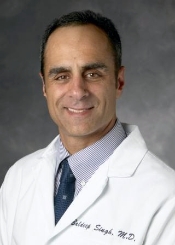Q&A Session with Baldeep Singh, MD
 Baldeep Singh, MD is Clinical Professor of Medicine in the Division of General Medical Disciplines (GMD) and the Clinic Chief of Stanford Internal Medicine.
Baldeep Singh, MD is Clinical Professor of Medicine in the Division of General Medical Disciplines (GMD) and the Clinic Chief of Stanford Internal Medicine.
In the fall of 2012, Dr. Singh was selected as Co-Medical Director of the Pacific Free Clinic (PFC) and he recently received the 2013 Community Service Award from the California-Hawaii Region of the Society for General Internal Medicine (SGIM), which honors SGIM members who have made significant contributions to improve the health of their community through advocacy and/or community service.
On February 25, 2013, GMD interviewed Dr. Singh to learn more about his experiences and goals for primary care and the PFC.
Q. Can you tell us more about how you became interested in community service?
I started becoming involved in outreach service during medical school and continued during residency by participating in free clinics affiliated with UCLA. After residency, I worked with the Federally Qualified Health Center and Homeless Shelter for two years in East Los Angeles. It was vital for me when returning to UCLA to continue this type of work. I chose to help develop a clinic at Venice Family Clinic, the largest free clinic in the US, into part of the residency program at UCLA to provide excellent care and great community service experience for the residents, which I volunteered at for 19 years. Since I arrived at Stanford I have been involved with both PFC and Arbor Clinic.
Q. Coming from UCLA in 2009, what are some of the parallels that you have found at both UCLA and Stanford in terms of care delivery and community service?
There are free clinic opportunities at both institutions serving similar populations and carrying out similar missions. The main difference is that UCLA, as an institution, appeared more committed to community involvement with the underserved, than Stanford has. Also, Medicine faculty and residents were more involved with the UCLA clinics, while at Stanford the effort has been mainly through the office of Community Health for the medical students. My hope is to help initiate a similar experience for the residents but this will require funding and time.
Q. What are the incentives and ways to get residents more involved?
Residents rotate through free clinics currently two to four times per year. That is positive and they have been enthusiastic about these rotations but I think our goal is to figure out how to do this in a more sustainable way. The free clinics focus on urgent care and this patient population needs more continuity care. We are working on a primary care track that may be able to incorporate the care goals and outreach components. We have been trying to push for community service as a fourth mission to the already existing three missions: research, education and clinical care. I think this is important given the immense influence and reputation that Stanford has.
Q. As Co-Director of the PFC, what are the clinical activities and your vision for the clinic?
My vision is to attempt to improve the strength of Stanford involvement and resources available of the outreach clinics. For example, we have proposed moving Arbor clinic to the Stanford Internal Medicine (SIM) clinic space on Sundays, which could serve as an easier venue to see patients compared to the current VA facility. Also, moving the site closer to campus offers more of a chance to get more residents and faculty involved.
At the PFC site, we see patients every Saturdays at a high school clinic in San Jose. We are situated in the heart of San Jose, where many of the lower socio-economic groups are located, which include populations such as recent immigrants and those who work but are uninsured.
Q. What advice would you give to medical students and residents who are thinking of primary care as a career?
I would say that there is a huge need for primary care in the next few decades given the aging of the population, the vast new groups of uninsured patients that will need care under the Affordable Care Act (ACA), the need to keep healthcare costs down, and the need to improve the quality of health care in the nation. This is best done through primary care.
Second, I think there is a feeling at Stanford, that primary care doesn’t have the glamour that some of the other subspecialties have but we feel like we should be attracting the best and the brightest in primary care just as we do for other subspecialties, because so many of the health care problems of the nation are going to be solved by strengthening and innovating in primary care.
I also think a lot of the future innovations in health care will occur in primary care. And primary care is a lot of fun.
Q. Have you seen an increase in enthusiasm since the time you started at Stanford?
Yes, I have. Just last week, I did an Osler event with Abraham Verghese. About 50 medical students attended and it was warmly received. We are trying to make sure we continue to fuel that idealism that medical students feel towards primary care early while their passion is strong so it will remain a driving force for them as they decide a specialty later in training.
How about with residents?
We need to do a better job with this overall. I think the enthusiasm will be better when we start a primary care track for the Medicine residents. The exposure and experience residents are currently getting is suboptimal. We have to think a little more creatively.
